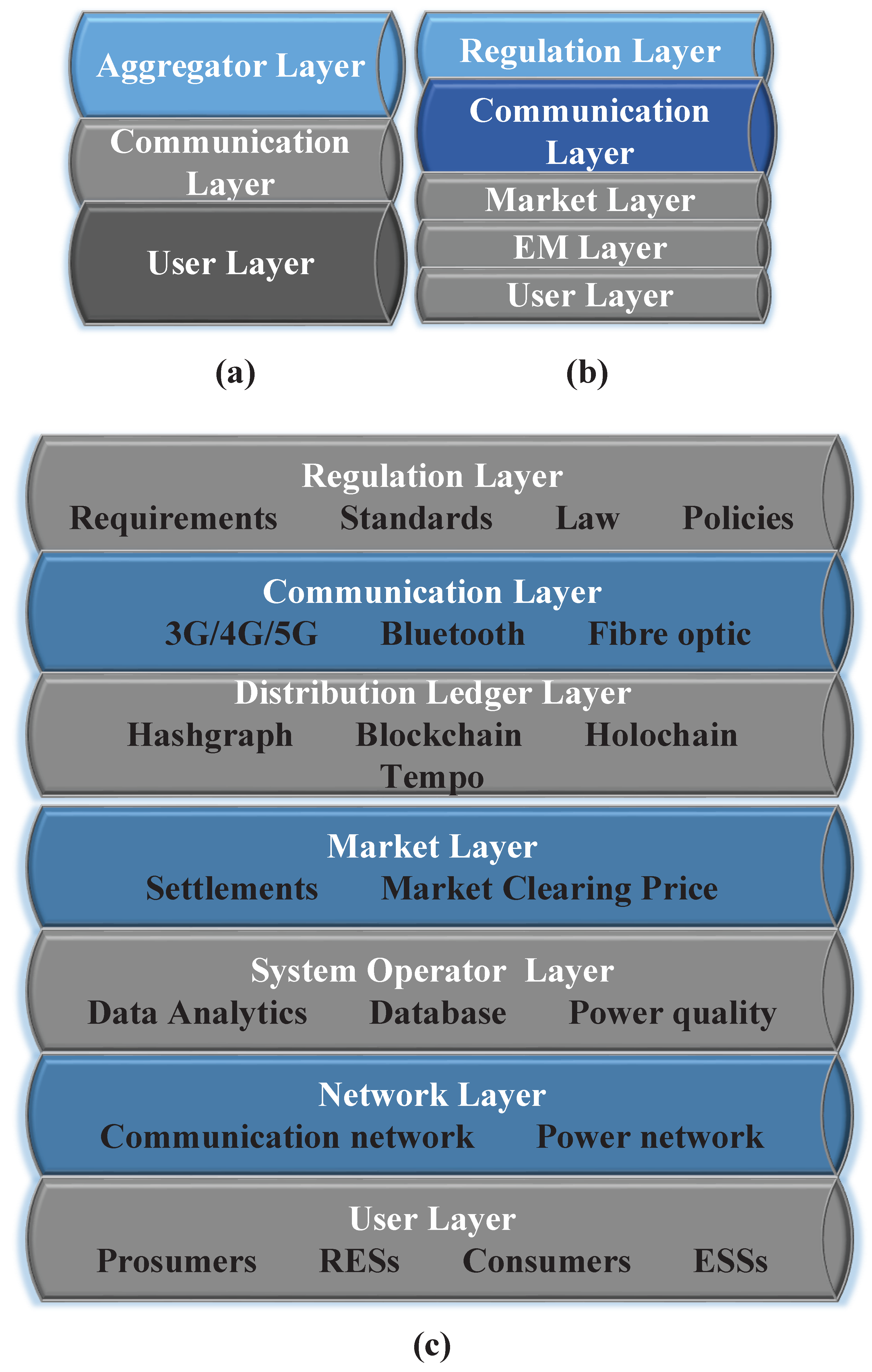The Role of Transactive Energy in the Future Energy Industry: A Critical Review
Abstract
:1. Introduction
- Emerging aspects, which may include fundamental drivers and designs for transactive energy, energy markets, control and management.
- An examination of recently developed technologies and innovations pertaining to TE-based management and control.
- The part that transactive energy plays in network hub systems, the new technologies and innovations that have been developed for TE, and the part that TE plays in the flexibility of power systems
- A variety of initiatives and challenges based on TE that have been completed and are still underway in their implementation.
2. Transactive Energy Concept and Defintions
“An internet-enabled free market, where customer devices and grid systems can barter over the proper way to solve their mutual problems, and settle on the proper price for their services, in close to real time.”[3]
“Techniques for managing the generation, consumption, or flow of electric power within an electric power system through the use of economic or market-based constructs while considering grid reliability constraints.”[2]
“A software-defined grid managed via market-based incentives to ensure grid reliability and resiliency. This is done with software applications that use economic signals and operational information to coordinate and manage devices’ production and/or consumption of electricity in the grid. TE describes the convergence of technologies, policies, and financial drivers in an active prosumer market where prosumers are buildings, electric vehicles, microgrids, VPPs or other assets.”
“A system of economic and control mechanisms that allows the dynamic balance of supply and demand across the entire electrical infrastructure using value as a key operational parameter.”[1]
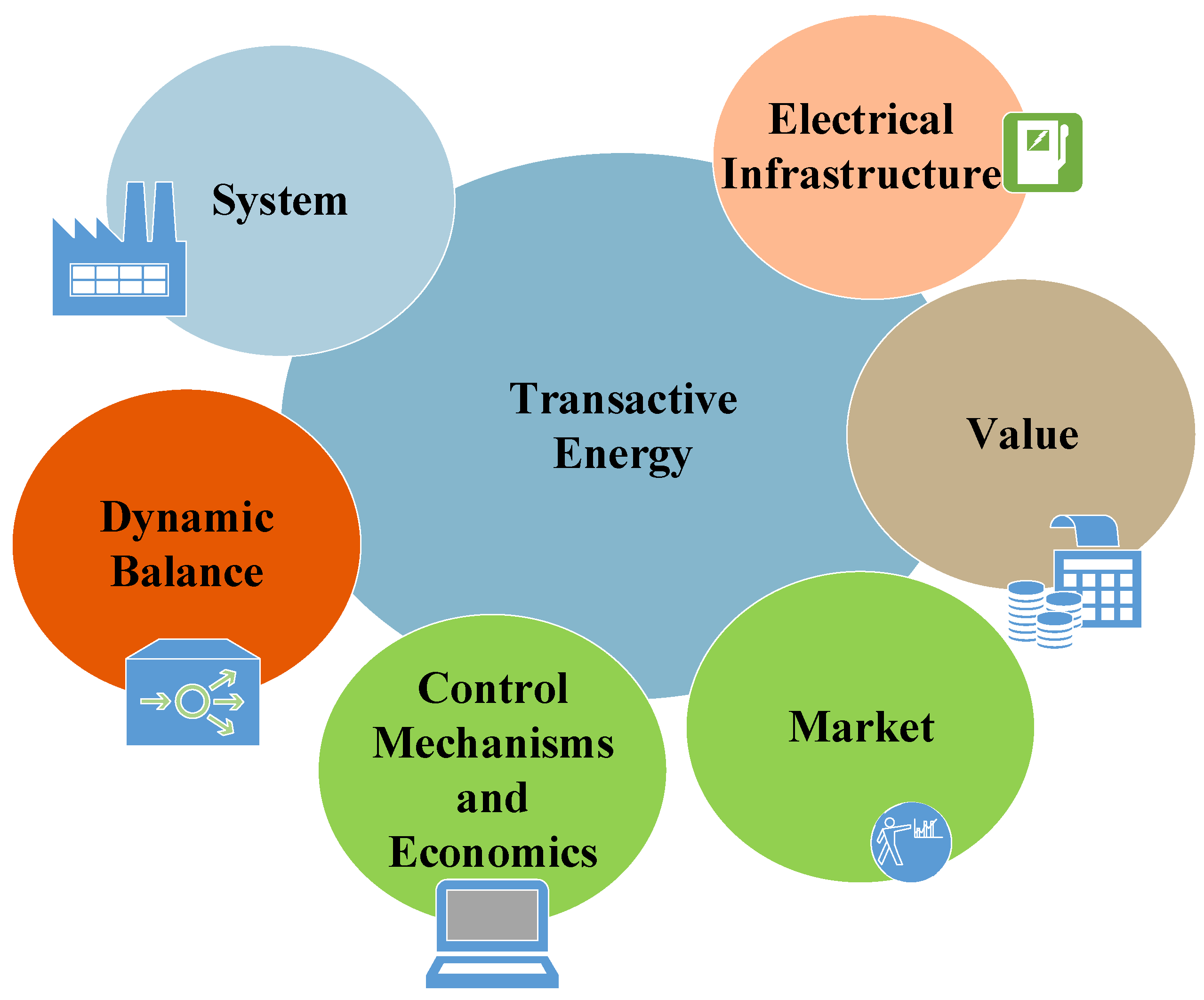
3. Key Drivers of Transactive Energy
- Grid operations, advanced control and communication technologies, microgrids, etc.
- Customer engagement as a producer.
- Grid modernization activities that includes incentives of the state.
4. Transactive Energy System Architecture
5. Energy Markets
- Full peer-to-peer (P2P) market;
- Community-based P2P market;
- Hybrid P2P market.

6. Transactive Energy-Based Control and Management
- Transactive control.
- Transactive network management.
- P2P markets.
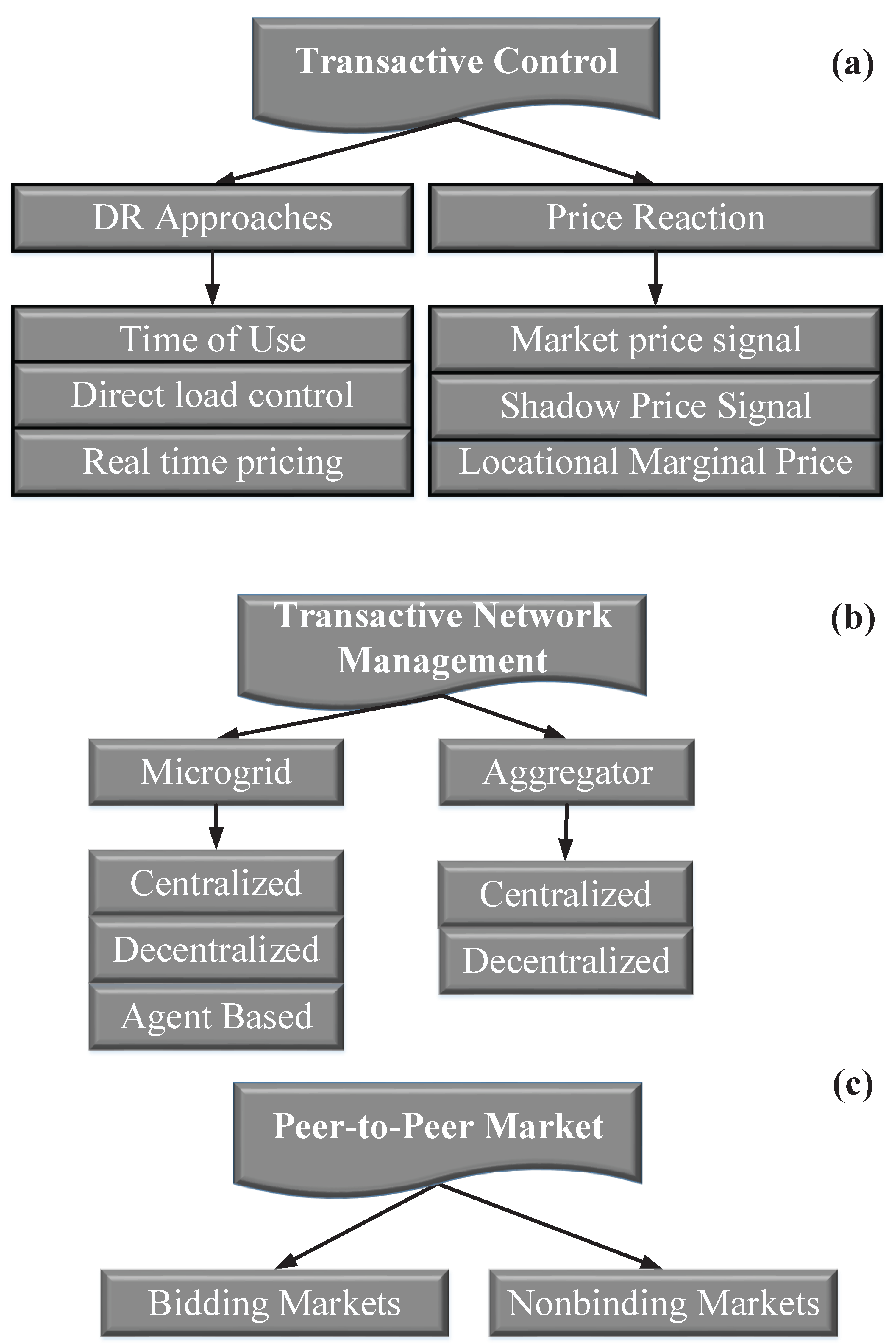
6.1. Transactive-Based Control
6.2. Network Management Based on Transactive Energy
6.3. P2P Markets
7. Transactive Energy in Networked Energy Hub Systems
8. New Technologies and Innovations in Transactive Energy
9. Transactive Energy-Based Power System Flexibility
10. Implemented Transactive Energy-Based Projects
11. Energy Industry Challenges with Transactive Energy Systems
12. Future Scope of Transactive Energy
- Developing mechanisms and methods for better usage of grid assets, which can reduce costs, especially during peak demand situations.
- When the grid is overloaded, developing customer response mechanisms that lower energy consumption can lessen the need for new power plants. By providing clients with the means to regulate and change the timing of their energy consumption, substantial daily swings in energy consumption can be mitigated.
- Increased usage of cost-effective, renewable energy generation (particularly from variable sources such as wind and solar) would necessitate new tools for running the grid, which TE may provide.
13. Conclusions
- When it comes to energy transactions, the concept of TE is progressing with a heavy emphasis on looking at things from a local, distribution-level point of view.
- The majority of the currently available strategies are merely presented in the form of models; there is no actual world implementation to facilitate full validation. However, before such an implementation can take place, it is important to construct and deploy appropriate simulation platforms and tools in order to conduct an in-depth analysis of the data that were acquired.
- In addition to this, every type of TE system needs to implement a design that is more effective in order to improve the reliability, adaptability, and accuracy of the results.
Author Contributions
Funding
Data Availability Statement
Conflicts of Interest
Abbreviations
| AMI | Advanced metering infrastructure |
| DR | Demand response |
| DSO | Distribution system operator |
| EMS | Energy management system |
| EV | Electrical vehicle |
| HEMS | Home energy management system |
| HVAC | High-voltage alternating current |
| IEH | Industrial energy hubs |
| ISO | Independant system operator |
| PNNL | Pacific Northwest National Laboratory |
| RES | Renewable energy sources |
| TCL | Thermostatically controlled loads |
| TE | Transactive energy |
| TES | Transactive energy system |
| VRE | Variable renewable energy |
References
- The GridWise Architecture Council. GridWise Transactive Energy Framework Version 1.0; Gridwise Architecture Council: Richland, WA, USA, 2015. [Google Scholar]
- Yin, S.; Wang, J.; Qiu, F. Decentralized electricity market with transactive energy—A path forward. Electr. J. 2019, 32, 7–13. [Google Scholar] [CrossRef]
- Jeff, S.; Jeff, S. A How-To Guide for Transactive Energy. Available online: https://www.greentechmedia.com/articles/read/a-how-to-guide-for-transactive-energy (accessed on 1 August 2022).
- Hertzog, C. Transactive Energy–American Perspectives on Grid Transformations. Available online: https://www.engerati.com/transmission-distribution/transactive-energy-american-perspectives-on-grid-transformations/ (accessed on 1 August 2022).
- Atamturk, N.; Zafar, M.; Energy, T. A Surreal Vision or a Necessary and Feasible Solution to Grid Problems? California Public Utilities Commission Policy & Planning Division: San Francisco, CA, USA, 2014.
- Nguyen, H.T.; Battula, S.; Takkala, R.R.; Wang, Z.; Tesfatsion, L. An integrated transmission and distribution test system for evaluation of transactive energy designs. Appl. Energy 2019, 240, 666–679. [Google Scholar] [CrossRef] [Green Version]
- Li, B.; Wan, C.; Yuan, K.; Song, Y. Demand response for integrating distributed energy resources in transactive energy system. Energy Procedia 2019, 158, 6645–6651. [Google Scholar] [CrossRef]
- Ahsan, U.; Bais, A. Distributed big data management in smart grid. In Proceedings of the 2017 26th Wireless and Optical Communication Conference (WOCC), Newark, NJ, USA, 7–8 April 2017; IEEE: Piscataway, NJ, USA, 2017; pp. 1–6. [Google Scholar]
- Afzal, M.; Umer, K.; Amin, W.; Naeem, M.; Cai, D.; Zhenyuan, Z.; Huang, Q. Blockchain based domestic appliances scheduling in community microgrids. In Proceedings of the 2019 IEEE Innovative Smart Grid Technologies-Asia (ISGT Asia), Chengdu, China, 21–24 May 2019; IEEE: Piscataway, NJ, USA, 2019; pp. 2842–2847. [Google Scholar]
- Andoni, M.; Robu, V.; Flynn, D.; Abram, S.; Geach, D.; Jenkins, D.; McCallum, P.; Peacock, A. Blockchain technology in the energy sector: A systematic review of challenges and opportunities. Renew. Sustain. Energy Rev. 2019, 100, 143–174. [Google Scholar] [CrossRef]
- U.S. Solar Market Insight. Solar Energy Industries Association (SEIA), 2018. Available online: https://www.seia.org/research-resources/solar-market-insight-report-2018-year-review (accessed on 1 August 2022).
- Khodayar, M.E.; Feizi, M.R.; Vafamehr, A. Solar photovoltaic generation: Benefits and operation challenges in distribution networks. Electr. J. 2019, 32, 50–57. [Google Scholar] [CrossRef]
- Zia, M.F.; Benbouzid, M.; Elbouchikhi, E.; Muyeen, S.; Techato, K.; Guerrero, J.M. Microgrid transactive energy: Review, architectures, distributed ledger technologies, and market analysis. IEEE Access 2020, 8, 19410–19432. [Google Scholar] [CrossRef]
- Holmberg, D.G.; Holmberg, D.G.; Bushby, S.T. NIST Transactive Energy Modeling and Simulation Challenge for the Smart Grid Phase I Report; US Department of Commerce, National Institute of Standards and Technology: Gaithersburg, MD, USA, 2018.
- Wu, Y.; Wu, Y.; Guerrero, J.M.; Vasquez, J.C. Digitalization and decentralization driving transactive energy Internet: Key technologies and infrastructures. Int. J. Electr. Power Energy Syst. 2021, 126, 106593. [Google Scholar] [CrossRef]
- Siano, P.; De Marco, G.; Rolán, A.; Loia, V. A survey and evaluation of the potentials of distributed ledger technology for peer-to-peer transactive energy exchanges in local energy markets. IEEE Syst. J. 2019, 13, 3454–3466. [Google Scholar] [CrossRef]
- Zia, M.F.; Elbouchikhi, E.; Benbouzid, M.; Guerrero, J.M. Microgrid transactive energy systems: A perspective on design, technologies, and energy markets. In Proceedings of the IECON 2019-45th Annual Conference of the IEEE Industrial Electronics Society, Lisbon, Portugal, 14–17 October 2019; IEEE: Piscataway, NJ, USA, 2019; Volume 1, pp. 5795–5800. [Google Scholar]
- Huang, Q.; Amin, W.; Umer, K.; Gooi, H.B.; Eddy, F.Y.S.; Afzal, M.; Shahzadi, M.; Khan, A.A.; Ahmad, S.A. A review of transactive energy systems: Concept and implementation. Energy Rep. 2021, 7, 7804–7824. [Google Scholar] [CrossRef]
- Abrishambaf, O.; Lezama, F.; Faria, P.; Vale, Z. Towards transactive energy systems: An analysis on current trends. Energy Strategy Rev. 2019, 26, 100418. [Google Scholar] [CrossRef]
- Yao, Y.; Zhang, P. Transactive control of air conditioning loads for mitigating microgrid tie-line power fluctuations. In Proceedings of the 2017 IEEE Power & Energy Society General Meeting, Chicago, IL, USA, 16–20 July 2017; IEEE: Piscataway, NJ, USA, 2017; pp. 1–5. [Google Scholar]
- Jin, D.; Zhang, X.; Ghosh, S. Simulation models for evaluation of network design and hierarchical transactive control mechanisms in smart grids. In Proceedings of the 2012 IEEE PES Innovative Smart Grid Technologies (ISGT), Berlin, Germany, 14–17 October 2012; IEEE: Piscataway, NJ, USA, 2012; pp. 1–8. [Google Scholar]
- Vickers, N.J. Animal communication: When i’m calling you, will you answer too? Curr. Biol. 2017, 27, R713–R715. [Google Scholar] [CrossRef]
- Baron-Prada, E.; Osorio, E.; Mojica-Nava, E. Resilient transactive control in microgrids under dynamic load altering attacks. In Proceedings of the 2017 IEEE 3rd Colombian Conference on Automatic Control (CCAC), Cartagena de Indias, Colombia, 18–20 October 2017; IEEE: Piscataway, NJ, USA, 2017; pp. 1–5. [Google Scholar]
- Fuller, J.C.; Schneider, K.P.; Chassin, D. Analysis of residential demand response and double-auction markets. In Proceedings of the 2011 IEEE Power and Energy Society General Meeting, Detroit, MI, USA, 24–29 July 2011; IEEE: Piscataway, NJ, USA, 2011; pp. 1–7. [Google Scholar]
- Fält, M.; Giselsson, P. Line search for generalized alternating projections. In Proceedings of the 2017 American Control Conference (ACC), Seattle, WA, USA, 24–26 May 2017; IEEE: Piscataway, NJ, USA, 2017; pp. 4637–4642. [Google Scholar]
- Hao, H.; Corbin, C.D.; Kalsi, K.; Pratt, R.G. Transactive control of commercial buildings for demand response. IEEE Trans. Power Syst. 2016, 32, 774–783. [Google Scholar] [CrossRef]
- Ayotamuno, M.; Kogbara, R.; Ogaji, S.; Probert, S. Petroleum contaminated ground-water: Remediation using activated carbon. Appl. Energy 2006, 83, 1258–1264. [Google Scholar] [CrossRef] [Green Version]
- Behboodi, S.; Chassin, D.P.; Djilali, N.; Crawford, C. Transactive control of fast-acting demand response based on thermostatic loads in real-time retail electricity markets. Appl. Energy 2018, 210, 1310–1320. [Google Scholar] [CrossRef]
- Nazir, M.S.; Hiskens, I.A. Load synchronization and sustained oscillations induced by transactive control. In Proceedings of the 2017 IEEE Power & Energy Society General Meeting, Chicago, IL, USA, 16–20 July 2017; IEEE: Piscataway, NJ, USA, 2017; pp. 1–5. [Google Scholar]
- Ramdaspalli, S.; Pipattanasomporn, M.; Kuzlu, M.; Rahman, S. Transactive control for efficient operation of commercial buildings. In Proceedings of the 2016 IEEE PES Innovative Smart Grid Technologies Conference Europe (ISGT-Europe), Ljubljana, Slovenia, 9–12 October 2016; IEEE: Piscataway, NJ, USA, 2016; pp. 1–5. [Google Scholar]
- Pratt, A.; Krishnamurthy, D.; Ruth, M.; Wu, H.; Lunacek, M.; Vaynshenk, P. Transactive home energy management systems: The impact of their proliferation on the electric grid. IEEE Electrif. Mag. 2016, 4, 8–14. [Google Scholar] [CrossRef]
- Katipamula, S.; Chassin, D.P.; Hatley, D.D.; Pratt, R.G.; Hammerstrom, D.J. Transactive Controls: A Market-Based Gridwisetm Controls for Building Systems; Technical Report; Pacific Northwest National Lab. (PNNL): Richland, WA, USA, 2006.
- Amin, U.; Hossain, M.; Lu, J.; Fernandez, E. Performance analysis of an experimental smart building: Expectations and outcomes. Energy 2017, 135, 740–753. [Google Scholar] [CrossRef]
- Katipamula, S. Smart buildings can help smart grid: Transactive controls. In Proceedings of the Innovative Smart Grid Technologies (ISGT), Washington, DC, USA, 16–20 January 2012; IEEE: Piscataway, NJ, USA, 2012; p. 1. [Google Scholar]
- Adhikari, R.; Pipattanasomporn, M.; Kuzlu, M.; Rahman, S. Simulation study of transactive control strategies for residential HVAC systems. In Proceedings of the 2016 IEEE PES Innovative Smart Grid Technologies Conference Europe (ISGT-Europe), Ljubljana, Slovenia, 9–12 October 2016; IEEE: Piscataway, NJ, USA, 2016; pp. 1–5. [Google Scholar]
- Widergren, S.; Fuller, J.; Marinovici, C.; Somani, A. Residential transactive control demonstration. In Proceedings of the ISGT 2014, Kuala Lumpur, Malaysia, 20–23 May 2014; IEEE: Piscataway, NJ, USA, 2014; pp. 1–5. [Google Scholar]
- Lian, J.; Sun, Y.; Kalsi, K.; Widergren, S.E.; Wu, D.; Ren, H. Transactive System: Part II: Analysis of Two Pilot Transactive Systems Using Foundational Theory and Metrics; Technical Report; Pacific Northwest National Lab. (PNNL): Richland, WA, USA, 2018.
- Divshali, P.H.; Choi, B.J.; Liang, H. Multi-agent transactive energy management system considering high levels of renewable energy source and electric vehicles. IET Gener. Transm. Distrib. 2017, 11, 3713–3721. [Google Scholar] [CrossRef] [Green Version]
- Behboodi, S.; Crawford, C.; Djilali, N.; Chassin, D.P. Integration of price-driven demand response using plug-in electric vehicles in smart grids. In Proceedings of the 2016 IEEE Canadian Conference on Electrical and Computer Engineering (CCECE), Vancouver, BC, Canada, 15–18 May 2016; IEEE: Piscataway, NJ, USA, 2016; pp. 1–5. [Google Scholar]
- Behboodi, S.; Chassin, D.P.; Crawford, C.; Djilali, N. Electric vehicle participation in transactive power systems using real-time retail prices. In Proceedings of the 2016 49th Hawaii international conference on system sciences (HICSS), Koloa, HI, USA, 5–8 January 2016; IEEE: Piscataway, NJ, USA, 2016; pp. 2400–2407. [Google Scholar]
- Hu, J.; Yang, G.; Bindner, H.W.; Xue, Y. Application of network-constrained transactive control to electric vehicle charging for secure grid operation. IEEE Trans. Sustain. Energy 2016, 8, 505–515. [Google Scholar] [CrossRef] [Green Version]
- Galvan, E.; Mandal, P.; Velez-Reyes, M.; Kamalasadan, S. Transactive control mechanism for efficient management of EVs charging in transactive energy environment. In Proceedings of the 2016 North American Power Symposium (NAPS), Denver, CO, USA, 18–20 September 2016; IEEE: Piscataway, NJ, USA, 2016; pp. 1–6. [Google Scholar]
- Hu, J.; Yang, G.; Bindner, H.W. Network constrained transactive control for electric vehicles integration. In Proceedings of the 2015 IEEE Power & Energy Society General Meeting, Denver, CO, USA, 26–30 July 2015; IEEE: Piscataway, NJ, USA, 2015; pp. 1–5. [Google Scholar]
- Cazalet, E.G.; Cox, W.T.; Considine, T.; Worrall, J. Considerations for designing and operating transactive grids and microgrids. Available online: https://www.researchgate.net/profile/Toby-Considine/publication/303920087_Considerations_for_Designing_and_Operating_Transactive_Grids_and_Microgrids/links/575da52108ae9a9c955a6f3f/Considerations-for-Designing-and-Operating-Transactive-Grids-and-Microgrids.pdf (accessed on 1 August 2022).
- Adil, A.M.; Ko, Y. Socio-technical evolution of Decentralized Energy Systems: A critical review and implications for urban planning and policy. Renew. Sustain. Energy Rev. 2016, 57, 1025–1037. [Google Scholar] [CrossRef]
- Rahimi, F.A.; Ipakchi, A. Transactive energy techniques: Closing the gap between wholesale and retail markets. Electr. J. 2012, 25, 29–35. [Google Scholar] [CrossRef]
- Rahimi, F.; Ipakchi, A. Using a transactive energy framework: Providing grid services from smart buildings. IEEE Electrif. Mag. 2016, 4, 23–29. [Google Scholar]
- Sanseverino, E.R.; Di Silvestre, M.L.; Gallo, P.; Zizzo, G.; Ippolito, M. The blockchain in microgrids for transacting energy and attributing losses. In Proceedings of the 2017 IEEE International Conference on Internet of Things (iThings) and IEEE Green computing and Communications (GreenCom) and IEEE Cyber, Physical and Social Computing (CPSCom) and IEEE Smart Data (SmartData), Exeter, UK, 21–23 June 2017; IEEE: Piscataway, NJ, USA, 2017; pp. 925–930. [Google Scholar]
- Cox, W.; Considine, T. Structured energy: Microgrids and autonomous transactive operation. In Proceedings of the 2013 IEEE PES Innovative Smart Grid Technologies Conference (ISGT), Washington, DC, USA, 24–27 February 2013; IEEE: Piscataway, NJ, USA, 2013; pp. 1–6. [Google Scholar]
- Khodayar, M.; Manshadi, S.; Vafamehr, A. The short-term operation of microgrids in a transactive energy architecture. Electr. J. 2016, 29, 41–48. [Google Scholar] [CrossRef]
- Good, N.; Ceseña, E.A.M.; Heltorp, C.; Mancarella, P. A transactive energy modelling and assessment framework for demand response business cases in smart distributed multi-energy systems. Energy 2019, 184, 165–179. [Google Scholar] [CrossRef] [Green Version]
- Mohammad, N.; Mishra, Y. Transactive market clearing model with coordinated integration of large-scale solar PV farms and demand response capable loads. In Proceedings of the 2017 Australasian Universities Power Engineering Conference (AUPEC), Melbourne, VIC, Australia, 19–22 November 2017; IEEE: Piscataway, NJ, USA, 2017; pp. 1–6. [Google Scholar]
- Qi, W.; Shen, B.; Zhang, H.; Shen, Z.J.M. Sharing demand-side energy resources—A conceptual design. Energy 2017, 135, 455–465. [Google Scholar] [CrossRef]
- Olivella-Rosell, P.; Bullich-Massagué, E.; Aragüés-Peñalba, M.; Sumper, A.; Ottesen, S.Ø.; Vidal-Clos, J.A.; Villafáfila-Robles, R. Optimization problem for meeting distribution system operator requests in local flexibility markets with distributed energy resources. Appl. Energy 2018, 210, 881–895. [Google Scholar] [CrossRef]
- MansourLakouraj, M.; Sanjari, M.J.; Javadi, M.S.; Shahabi, M.; Catalão, J.P.S. Exploitation of Microgrid Flexibility in Distribution System Hosting Prosumers. IEEE Trans. Ind. Appl. 2021, 57, 4222–4231. [Google Scholar] [CrossRef]
- Geidl, M.; Koeppel, G.; Favre-Perrod, P.; Klöckl, B.; Andersson, G.; Fröhlich, K.J.D.I. The Energy Hub: A Powerful Concept for Future Energy Systems. In Proceedings of the Third Annual Carnegie Mellon Conference on the Electricity Industry, Pittsburgh, PA, USA, 13–14 March 2007. [Google Scholar]
- Optimal day-ahead scheduling of microgrid with hybrid electric vehicles using MSFLA algorithm considering control strategies. Sustain. Cities Soc. 2021, 66, 102681. [CrossRef]
- Javadi, M.S.; Nezhad, A.E.; Jordehi, A.R.; Gough, M.; Santos, S.F.; Catalão, J.P. Transactive energy framework in multi-carrier energy hubs: A fully decentralized model. Energy 2022, 238, 121717. [Google Scholar] [CrossRef]
- Karimi, H.; Bahmani, R.; Jadid, S.; Makui, A. Dynamic transactive energy in multi-microgrid systems considering independence performance index: A multi-objective optimization framework. Int. J. Electr. Power Energy Syst. 2021, 126, 106563. [Google Scholar] [CrossRef]
- Daneshvar, M.; Mohammadi-Ivatloo, B.; Zare, K.; Asadi, S.; Anvari-Moghaddam, A. A Novel Operational Model for Interconnected Microgrids Participation in Transactive Energy Market: A Hybrid IGDT/Stochastic Approach. IEEE Trans. Ind. Inform. 2021, 17, 4025–4035. [Google Scholar] [CrossRef]
- Gholizadeh, N.; Abedi, M.; Nafisi, H.; Marzband, M.; Loni, A.; Putrus, G.A. Fair-Optimal Bilevel Transactive Energy Management for Community of Microgrids. IEEE Syst. J. 2021, 16, 2125–2135. [Google Scholar] [CrossRef]
- Zare Oskouei, M.; Teimourzadeh Baboli, P.; Babazadeh, D. Robust Stochastic Optimization for Energy Sharing between Multi-Carrier Microgrids using Transactive Energy Management System. In Proceedings of the ETG Congress 2021, Online, 18–19 March 2021; pp. 1–6. [Google Scholar]
- Oskouei, M.Z.; Mohammadi-Ivatloo, B.; Abapour, M.; Shafiee, M.; Anvari-Moghaddam, A. Strategic Operation of a Virtual Energy Hub With the Provision of Advanced Ancillary Services in Industrial Parks. IEEE Trans. Sustain. Energy 2021, 12, 2062–2073. [Google Scholar] [CrossRef]
- A novel transactive energy trading model for modernizing energy hubs in the coupled heat and electricity network. J. Clean. Prod. 2022, 344, 131024. [CrossRef]
- Katipamula, S.; Corbin, C.D.; Haack, J.N.; Hao, H.; Kim, W.; Hostick, D.J.; Akyol, B.A.; Allwardt, C.H.; Carpenter, B.J.; Huang, S.; et al. Transactive Campus Energy Systems; Technical Report; Pacific Northwest National Lab. (PNNL): Richland, WA, USA, 2017.
- LO3Energy, The Brooklyn Microgrid. Available online: https://lo3energy.com/ (accessed on 1 August 2022).
- Khorram, M.; Faria, P.; Abrishambaf, O.; Vale, Z. Lighting consumption optimization in an office building for demand response participation. In Proceedings of the 2018 Clemson University Power Systems Conference (PSC), Charleston, SC, USA, 4–7 September 2018; IEEE: Piscataway, NJ, USA, 2018; pp. 1–5. [Google Scholar]
- Khorram, M.; Abrishambaf, O.; Faria, P.; Vale, Z. Office building participation in demand response programs supported by intelligent lighting management. Energy Inform. 2018, 1, 9. [Google Scholar] [CrossRef]
- Prinsloo, G.; Mammoli, A.; Dobson, R. Participatory smartgrid control and transactive energy management in community shared solar cogeneration systems for isolated rural villages. In Proceedings of the 2016 IEEE Global Humanitarian Technology Conference (GHTC), Seattle, WA, USA, 19–23 October 2021; IEEE: Piscataway, NJ, USA, 2016; pp. 352–359. [Google Scholar]
- Coalition, S.E.D. Mapping Demand Response in Europe Today 2015. Available online: http://www.smartenergydemand.eu/wp-content/uploads/2015/09/Mapping-Demand-Response-in-Europe-Today-2015.pdf (accessed on 1 August 2022).
- Hahn, A.; Singh, R.; Liu, C.C.; Chen, S. Smart contract-based campus demonstration of decentralized transactive energy auctions. In Proceedings of the 2017 IEEE Power & Energy Society Innovative Smart Grid Technologies Conference (ISGT), Arlington, VA, USA, 23–26 April 2017; IEEE: Piscataway, NJ, USA, 2017; pp. 1–5. [Google Scholar]
- Di Silvestre, M.L.; Dusonchet, L.; Favuzza, S.; Ippolito, M.G.; Mangione, S.; Massaro, F.; Mineo, L.; Sanseverino, E.R.; Telaretti, E.; Zizzo, G. Transparency in transactive energy at distribution level. In Proceedings of the 2017 AEIT International Annual Conference, Cagliari, Italy, 20–22 September 2017; IEEE: Piscataway, NJ, USA, 2017; pp. 1–5. [Google Scholar]
- Daneshvar, M.; Pesaran, M.; Mohammadi-ivatloo, B. 7-Transactive energy in future smart homes. In The Energy Internet; Su, W., Huang, A.Q., Eds.; Woodhead Publishing: Sawston, UK, 2019; pp. 153–179. [Google Scholar] [CrossRef]
- Heggarty, T.; Bourmaud, J.Y.; Girard, R.; Kariniotakis, G. Quantifying power system flexibility provision. Appl. Energy 2020, 279, 115852. [Google Scholar] [CrossRef]
- Yeloha Website. Available online: http://www.yeloha.com/ (accessed on 1 August 2022).
- Worral, J.; Cazalet, E.G.; Cox, W.; Rajagopal, N.; Nudell, T.R.; Heitmann, P. Transactive energy challenge energy management in microgrid systems. Trans. Syst. Conf. 2016, 1–11. [Google Scholar]
- Pacific Northwest National Laboratory. Available online: www.pnnl.gov/explainer-articles/transactive-energy (accessed on 1 August 2022).
- Transactive System: Part I: Theoretical Underpinnings of Payoff Functions, Control Decisions, Information Privacy, and Solution Concepts. Available online: https://www.osti.gov/biblio/1530612 (accessed on 1 August 2022).
- ELECTRON. Available online: http://www.electron.org.uk/ (accessed on 1 August 2022).
- Lichtblick Swarm Energy. Available online: https://www.lichtblickblog.de/en/swarmenergy/schwarmdirigent-worldwide-distributed-energy/ (accessed on 1 August 2022).
- Sonnen Community. Available online: https://sonnenbatterie.de/en/sonnenCommunity (accessed on 1 August 2022).
- Smart Watts. Available online: https://www.iis.fraunhofer.de/en/ff/lv/ener/proj/smart-watts.html (accessed on 1 August 2022).
- SmarTest. Available online: http://www.p2psmartest-h2020.eu/ (accessed on 1 August 2022).
- Peer Energy Cloud. Available online: http://software-cluster.org/projects/peer-energy-cloud/ (accessed on 1 August 2022).
- Vandebron. Available online: https://vandebron.nl/ (accessed on 1 August 2022).
- Renewable Energy for Businesses, P.L. Available online: https://piclo.uk (accessed on 1 August 2022).
- Share and Charge. Available online: https://shareandcharge.com/ (accessed on 1 August 2022).
- Powerpeer. Available online: https://www.powerpeers.nl/hoe-werkt-het/ (accessed on 1 August 2022).
- Couperus Smart Grid. Available online: http://flexiblepower.github.io/cases/in-operation/ (accessed on 1 August 2022).
- Bullich-Massagué, E.; Aragüés-Peñalba, M.; Olivella-Rosell, P.; Lloret-Gallego, P.; Vidal-Clos, J.A.; Sumper, A. Architecture definition and operation testing of local electricity markets. The EMPOWER project. In Proceedings of the 2017 International Conference on Modern Power Systems (MPS), Cluj-Napoca, Romania, 6–9 June 2017; pp. 1–5. [Google Scholar] [CrossRef] [Green Version]
- Lee, D.; Hess, D.J.; Neema, H. The challenges of implementing transactive energy: A comparative analysis of experimental projects. Electr. J. 2020, 33, 106865. [Google Scholar] [CrossRef]

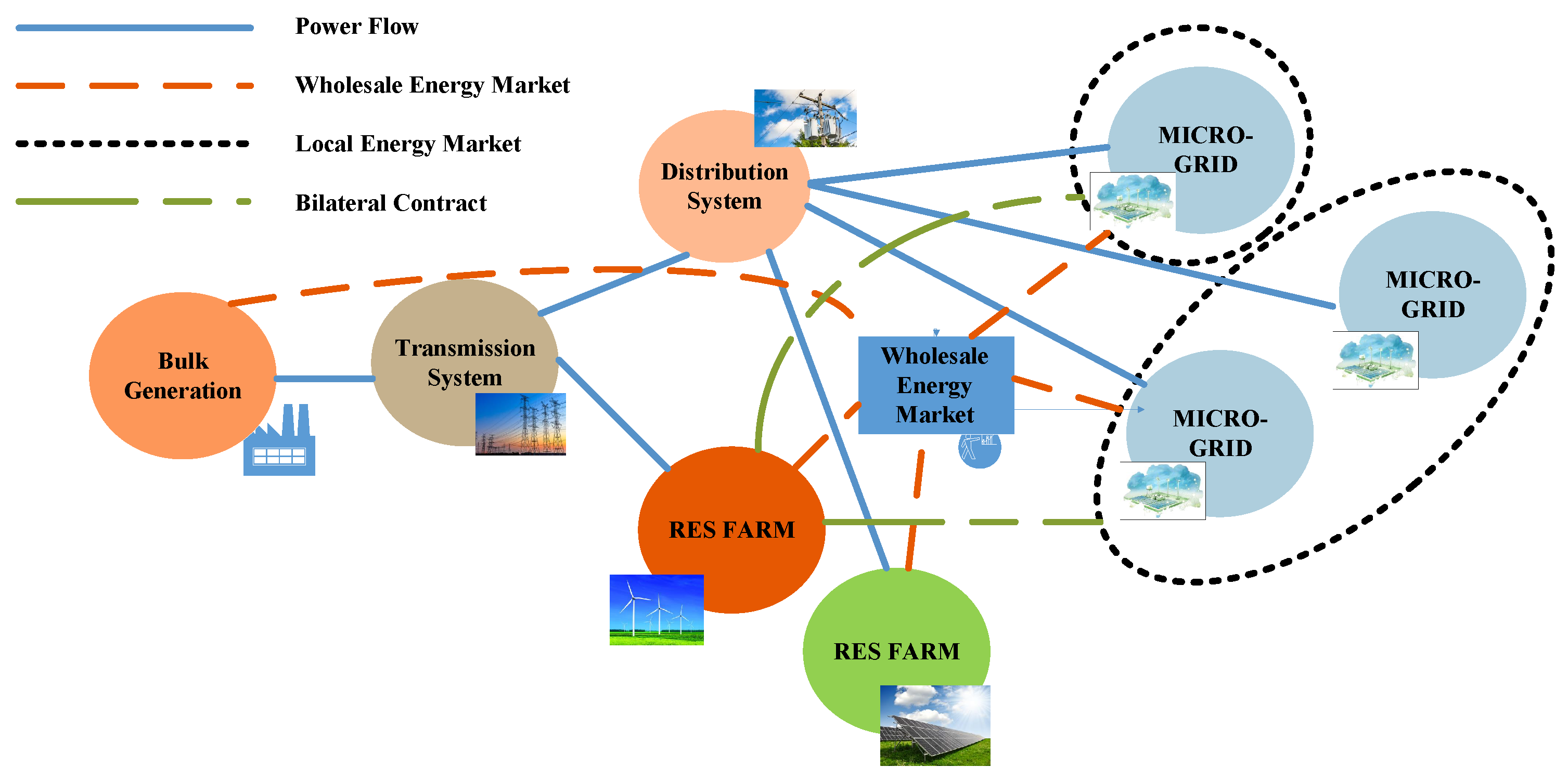
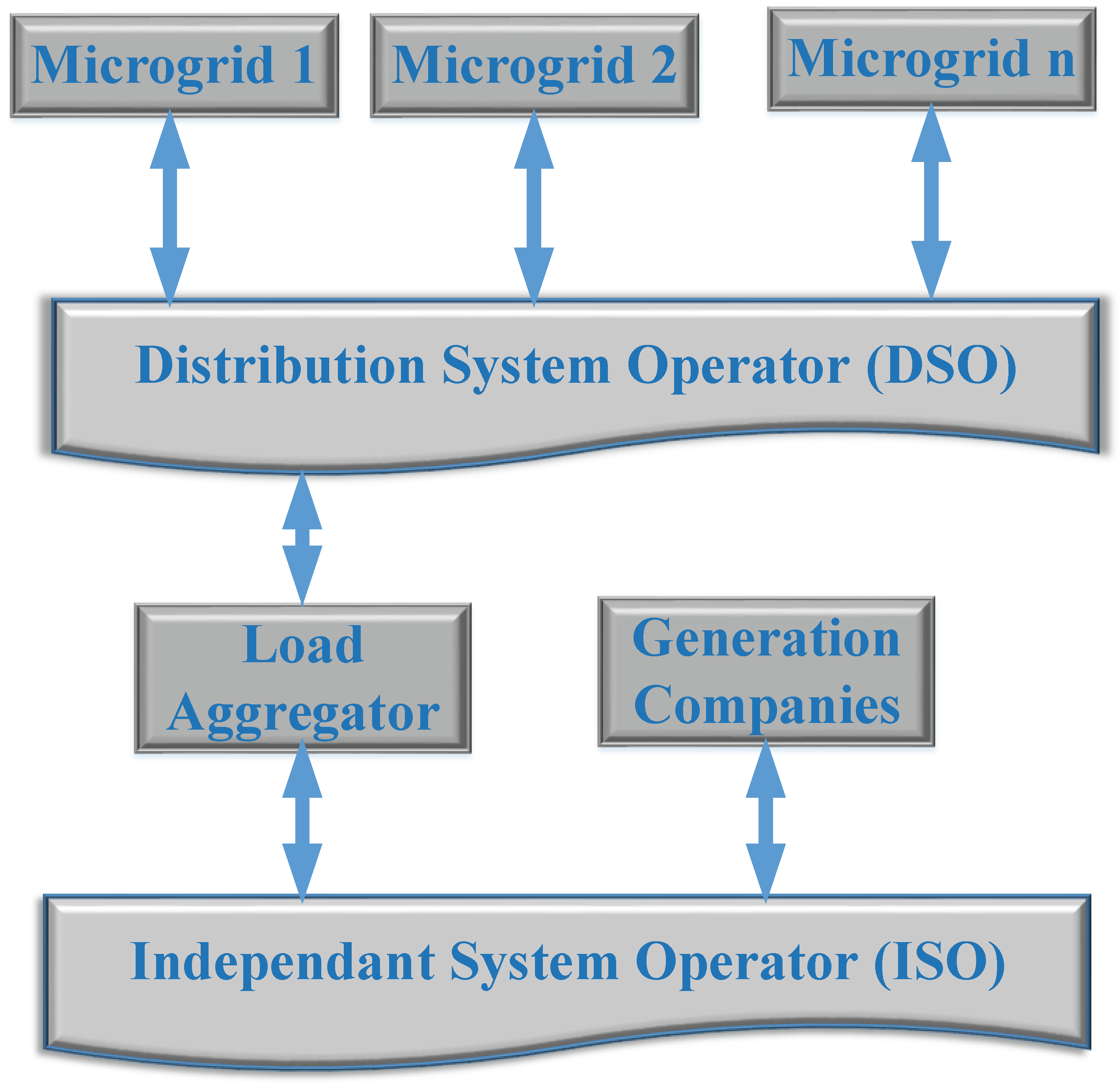
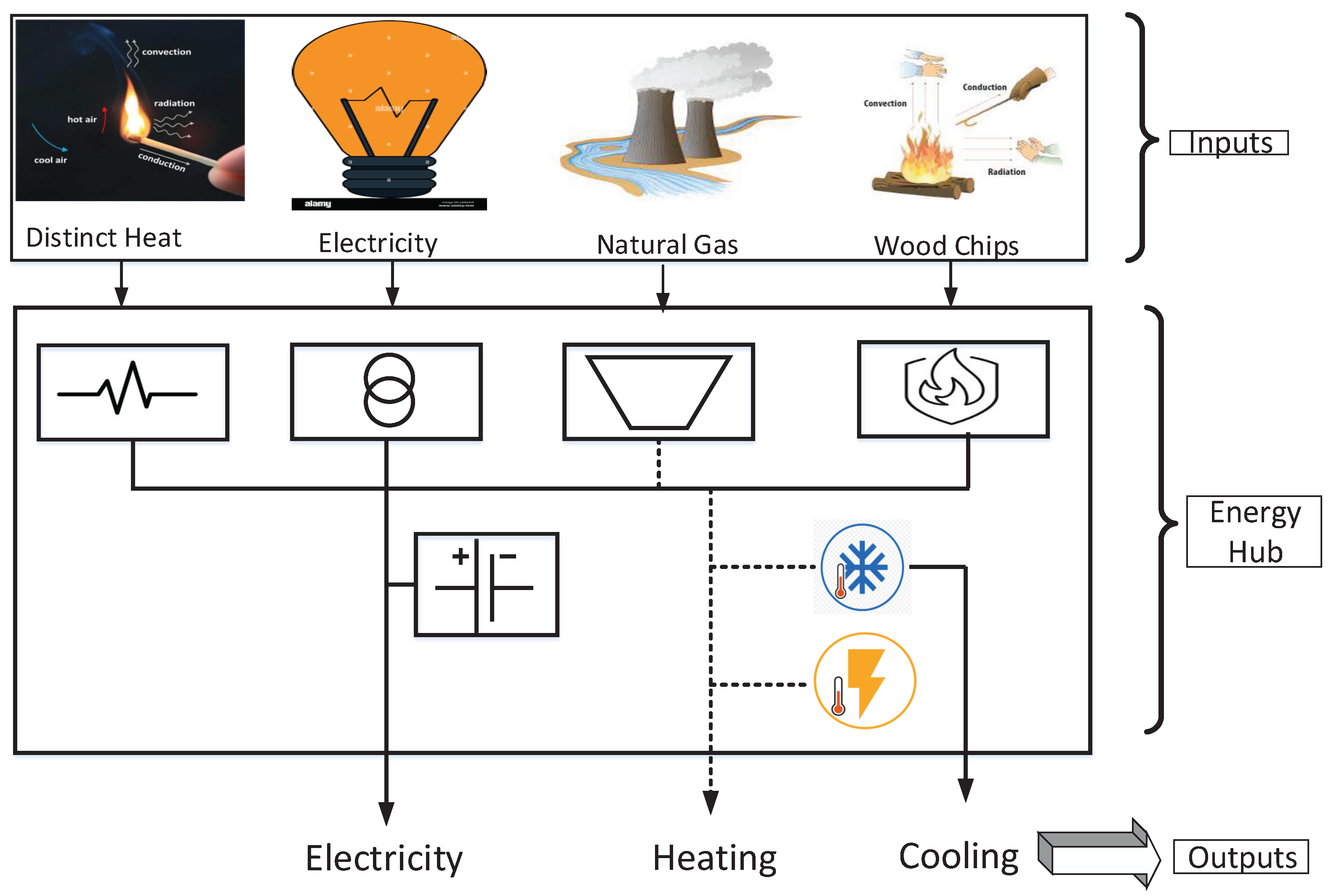
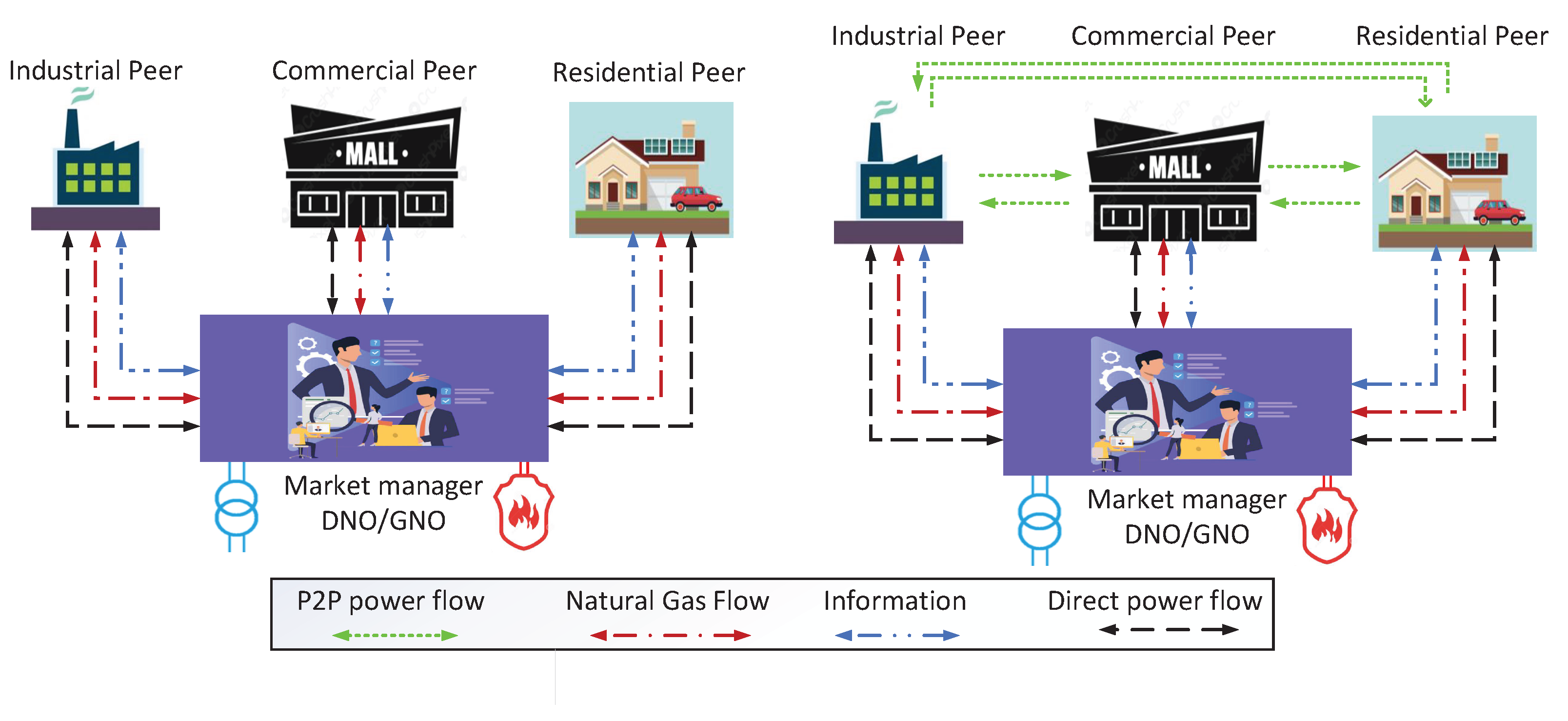
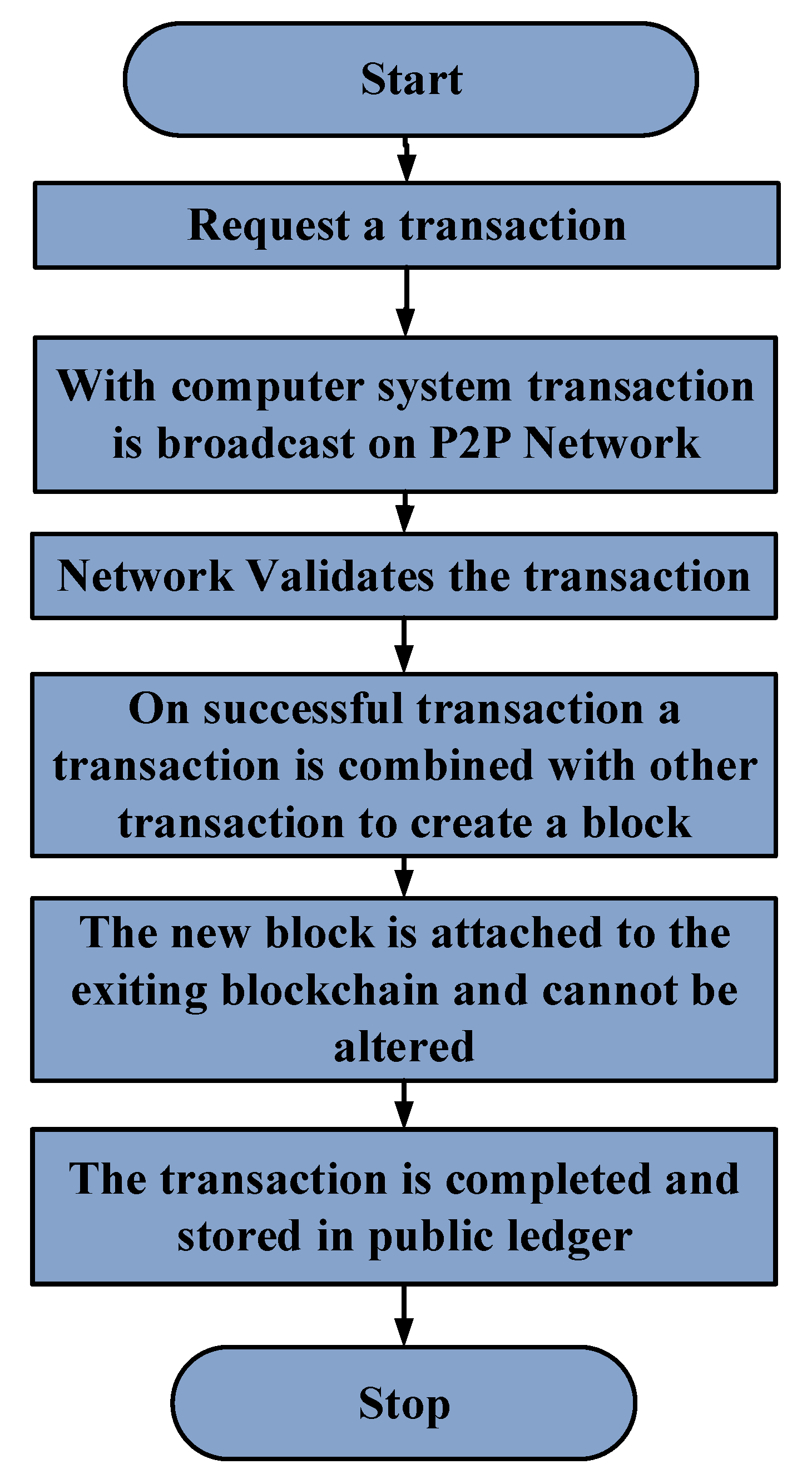
| References | Project Title and Features |
|---|---|
| [75] | Kealoha:- Established a software platform for the P2P exchange of excess solar energy between households. |
| [76] | Temix:- a decentralised network management and automated energy transaction initiative, has been implemented. |
| [66] | The Brooklyn microgrid:- The energy trading between the prosumers in typical power network have been demonstrated. |
| [46] | OATI Microgrid Center:- Sophisticated control and optimization software for a microgrid testbed has been implemented along with IoT devices to adapt them automatically to transactive control. |
| [78] | Clean Energy and Transactive Campus:- Implemented a multicampus testbed for transactive control and TE management experiments. Olympic Peninsula Grid-Wise project:- Automatic Load Response to Price Variations in a Very Short Timeframe initiative has been implemented. PowerMatcher:- Created a Smart grid coordination mechanism that takes into account distributed energy resources and flexible loads. |
| [36] | AEP gridSMART:- The Intelligent software platform for operating on the real-time market was deployed. |
| [79] | Energy ELECTRON:- Created a modular system for electricity metering and billing for energy sectors. |
| [80] | Lichtblick Swarm Energy:- Involves the development of an IT platform to link users and maximise the usage of local DER, has been implemented in Germany. |
| [81] | Sonnen Community:- P2P energy sharing platform considering a virtual energy pool has been built in Germany. |
| [82] | Smart Watts:- Novel approaches for energy optimization through ICT have been developed in Germany. |
| [83] | P2P–smartest:- A demonstration of a smart grid based on TE ideas capable of P2P energy trading has been established in Finland. |
| [84] | Peer Energy Cloud:- Germany has created a cloudbased platform for local energy trading and smart houses. |
| [85] | Vandebron:- Explored P2P energy trading from both the provider and client perspectives in Netherlands. |
| [86] | Piclo:- Network operators’ software platforms for P2P energy trading have been established in the United Kingdom. |
| [87] | ShareCharge project:- Germany has established a decentralised system for EV charging, transactions, and data sharing. |
| [88] | Powerpeers:- A Blockchainbased P2P market for energy trading has been created in the Netherlands. |
| [89] | Couperus Smart Grid project:- Uses PowerMatcher technology to coordinate energy consumption and reduce peak load in Netherlands. |
| [89] | EMPower:- Established a trading platform for local energy exchange on local markets in Norway. |
| Issues Addressed | References | Features |
|---|---|---|
| Key Drivers | [14,15] |
|
| Transactive energy architecture | [13,16,17] |
|
| Energy markets | [18] |
|
| Transactive energy based control and management | [19,20,21,22,23,24,25,26,27,28,29,44,45,46,47,48,49,50,51,52,53,54] | Transactive control, Transactive network management, P2P markets. Transactive based control:-
|
| Issues Addressed | References | Features |
|---|---|---|
| Transactive energy architecture energy hub systems | [55,56,57,58,59,60,61,62,63,64] |
|
| New technologies and innovations in transactive energy | [16,18,31,67,68,69,70,71,72,73,74] |
solution for smooth and effective working of TE systems.
|
| Transactive energy based power system flexibility | [16,19,76] |
|
Publisher’s Note: MDPI stays neutral with regard to jurisdictional claims in published maps and institutional affiliations. |
© 2022 by the authors. Licensee MDPI, Basel, Switzerland. This article is an open access article distributed under the terms and conditions of the Creative Commons Attribution (CC BY) license (https://creativecommons.org/licenses/by/4.0/).
Share and Cite
Gupta, N.; Prusty, B.R.; Alrumayh, O.; Almutairi, A.; Alharbi, T. The Role of Transactive Energy in the Future Energy Industry: A Critical Review. Energies 2022, 15, 8047. https://doi.org/10.3390/en15218047
Gupta N, Prusty BR, Alrumayh O, Almutairi A, Alharbi T. The Role of Transactive Energy in the Future Energy Industry: A Critical Review. Energies. 2022; 15(21):8047. https://doi.org/10.3390/en15218047
Chicago/Turabian StyleGupta, Neeraj, B Rajanarayan Prusty, Omar Alrumayh, Abdulaziz Almutairi, and Talal Alharbi. 2022. "The Role of Transactive Energy in the Future Energy Industry: A Critical Review" Energies 15, no. 21: 8047. https://doi.org/10.3390/en15218047







